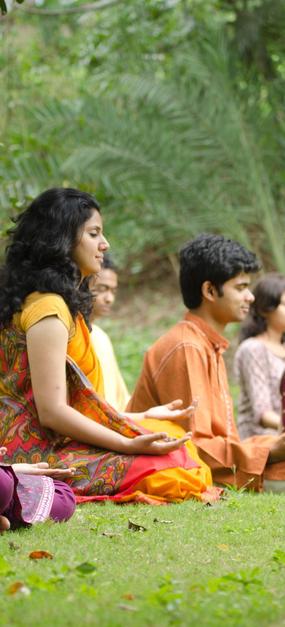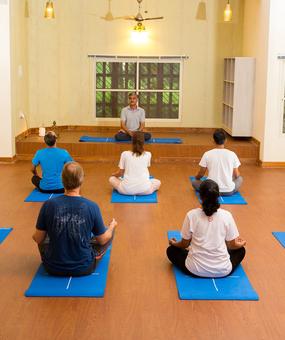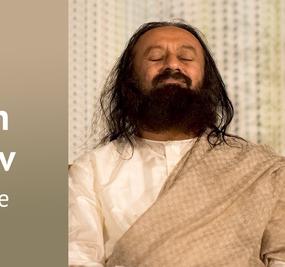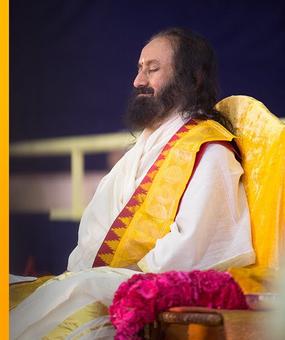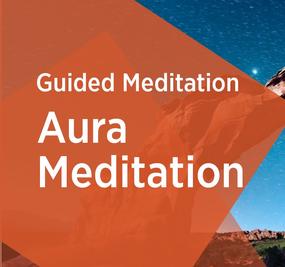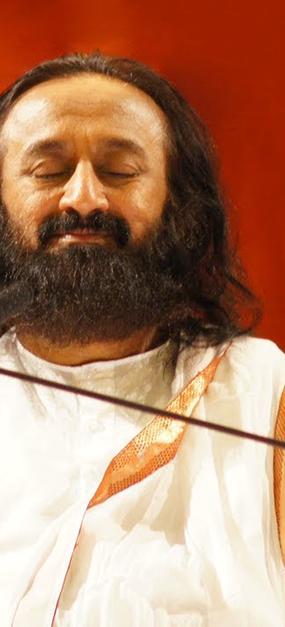What is Meditation?
Meditation is not concentration. This is a common misconception. It is not sitting and thinking about something. It is deep rest, a conscious relaxation. We all want a deep relaxation that refreshes us, so that we can be useful when we wake up. But when can you rest? Only when you have stopped all other activities. Meditation is the delicate art of doing nothing.
Meditation is the AC for the mind – absolute comfort! We want comfort, but we don’t know how to be absolutely comfortable. Meditation provides the way.
There are many ways to meditate and multiple types of meditation. When Gurudev Sri Sri Ravi Shankar first started teaching meditation more than forty-five years ago, yoga and meditation were thought to be not for the mainstream people. They used to think it was for someone remote or isolated, not for the common people. However, today, approximately one-third of the world’s population practices yoga and meditation.
Types of Meditation for Beginners
If you search the internet, you will find many ways to categorise meditation. Typically, the types mentioned are the following:
- Mindfulness meditation
- Loving kindness or compassion meditation
- Focussed attention
- Movement or Yoga meditation
- Zen, breathing meditation
- Mantra meditation
- Chanting meditation
- Automatic Self-Transcending
However, based on the Vedic origins of meditation, there is a more fundamental way to identify the types of meditation. Knowing this, you can figure out which meditation will work best for you – at this moment. Over time, you may try out other meditation techniques, but remember to give a method enough time and practice. Let us explore these types of meditation:
1. Yoga and Physical:
The first is through yoga and physical exercise. When our body does certain postures, with a specific rhythm, the mind slips into meditation. By stretching and contracting the body, the mind enters a state of awareness that can be called meditation. Exercise can bring a certain amount of calmness to the mind. Not totally, but a certain degree of meditativeness can come through exercise and physical manipulation. Yoga and Tai-Chi are examples of ways to experience a meditative state of mind through physical manipulation. This physical aspect is used in many “Movement meditation” techniques.
2. Breathing Techniques and “Pranayama”
The second is through breathing techniques and ‘pranayama’. The mind becomes quiet and still, and you can slip into meditation effortlessly. Through the breath, the mind becomes quiet and can easily slip into meditation. Sudarshan Kriya™ is a prime example. After pranayama and Sudarshan Kriya, when you sit for meditation, you slip into meditation effortlessly. So a breathing technique is one way to get into meditation.
Research from Singapore found that regular practice of Sudarshan Kriya Yoga is linked to significantly better sleep quality and lower stress [PubMed, 2020]
3. Using the senses:
The third is through any sensory pleasure — sight, sound, taste, smell or touch. Being 100 per cent engrossed in a particular sensory object brings you to a state of meditation. Through any of the five senses and sensory objects, one can experience a state of no-mindedness – no thoughts, calmness, serenity, and inner beauty.
The five sensory organs are related to the five elements. The world is of five elements: earth, water, air, fire and ether. Fire is connected with the eyes, smell with the earth element, taste with the water element, sound with the ether element and touch is connected with the air element. If you are in water or a swimming pool, you don’t feel the touch so much. Have you noticed that? Not so much, but a little bit. This is because the five elements are present in each one of them. There is an air element even in water, but to a small degree. So these five elements in the universe are connected to the five senses. And you can go through any one of the senses to transcend them and become one in a very deep meditative state.
If you observe a child eating a lollipop, you can see how the child is totally engrossed in enjoying that piece of candy. At that time, if you ask the child what their name is, they won’t answer! They are fully into enjoying the lollipop. Being 100% engrossed in a particular sensory object brings you to a state of meditation. A Harvard review of 47 clinical trials showed that mindfulness meditation reduces stress, anxiety, and depression [Harvard Health, 2014]
This principle is employed partially in mindfulness, chanting meditation and focused-attention meditation.
4. Emotions:
The fourth way is through both positive and negative emotions. When you feel utterly hopeless or very angry, you say, ‘I give up!’ It means, ‘This is it. I can’t take it anymore.’ A state of shock can also take you into meditation. During those moments, if you don’t slip into frustration, depression, or violence, you will find that there is a moment where it snaps and there is no-mindedness. So, whether it is positive emotions or negative emotions, like fear, the mind stands still; it stops. It can lead you into that same stillness. “Loving kindness” and “compassion meditation” refer to using emotions for meditation. Neuroscience research at the University of Wisconsin found that compassion meditation activates brain regions linked to empathy and emotional regulation. [UW–Madison, 2008]
5. Knowledge and Awareness:
The fifth is through the intellect, knowledge, and awareness. This is called Jnana Yoga. If you have studied Quantum Physics, you start to see that everything is just atoms, or just energy. If you delve into Quantum Physics and then you study Vedanta or the Art of Meditation or Yoga, you will find striking similarities. You will find that the same language is being spoken. In this context, when you sit and know that this body is made up of billions of cells, something gets stimulated deep inside.
If you visit a space museum, you will be in a different state of consciousness when you come out of the museum. You will experience a shift inside you because you have seen yourself in the context of the universe. Who are you? What are you? Where are you? What are you in reference to the unfathomable, infinite universe? The context of life immediately changes when you become aware of the magnanimity of the universe: Some shift happens within you. This can take you into meditation.
6. Personal mantra
Meditation is the skill to move the mind from a state of chaos to a state of bliss, from restlessness to deep restfulness. In this process, we can make use of a sound, the primordial sound, some of the ancient sounds, which are called mantra, to make the mind go to the state of silence. That which brings the mind from small to big mind is the mantra. That which brings the desirous mind into a contented mind. That which is the seed of your life. When mind and mantra are one, meditation happens.
This type of meditation is often categorised as Mantra or Automatic Self-Transcending meditation. Experts note that mantra-based meditation (like Sahaj Samadhi) helps the mind settle quickly and can be among the most effective forms for deep rest [Psychology Today, 2021]
Sahaj Samādhi Meditation” is a technique that uses this principle. It is the easiest, and in some ways the most beautiful way of meditating. “Sahaj” – which means simple. It’s a very natural way of transcending thoughts and going into the source of our existence. So what you do is you take a personal mantra and you keep it inside. It is like sowing a seed and covering the soil on top. Then that seed has roots below and shoots above. “Sahaj Samādhi” is such a sowing of the seed of meditation. Then you know, every day you practice, and you will see so much bliss and clarity, calmness, and intuition. Everything springs in life. And this you can do anywhere you are travelling in the train, car or plane.
Finally, to meditate, you just need to know how to relax. If you are on a massage table, you let the masseur take care of you. Similarly, in meditation, you do nothing. Let nature or the spirit take care of you. Meditation can transform the quality of your life by culturing the nervous system to maintain peace, energy and expanded awareness throughout the day. When you grow into higher states of consciousness, you find that you are no longer thrown off balance by different situations and disturbances. A regular practice can transform the quality of your life by culturing the nervous system to maintain peace, energy and expanded awareness throughout the day. You become beautiful yet strong, capable of accommodating different challenges in life without any conditions.
Resources
- Download the Sattva app and try out any of the types of meditation mentioned here for Free
- Subscribe to Youtube channel Meditations by Gurudev
- Sign up for Sahaj Samadhi meditation:
FAQ on Types of Meditation
Through a personal mantra
Through the body (yoga, movement-based meditations)
Through the breath (pranayama, Sudarshan Kriya)
Through the senses (mindfulness, chanting, focused attention)
Through emotions
Through a personal mantra
If you enjoy movement, try yoga-based meditation
If you find peace in breath, try Sudarshan Kriya or pranayama.
If you’re emotionally sensitive, try this meditation on transforming emotions
If you seek effortlessness, start with Sahaj Samadhi using a personal mantra.
Mantra meditation, like Sahaj Samadhi, uses a specific sound or word (mantra) to gently draw the mind inward, often leading to a more effortless and transcendent state of deep rest.
References
- PubMed. The association of Sudarshan Kriya Yoga frequency with sleep quality: a cross-sectional study from Singapore.
- Harvard Health. Meditation may ease anxiety, mental stress.
- University of Wisconsin–Madison News. Study shows meditation changes the brain.
- Psychology Today. What type of meditation is best?





